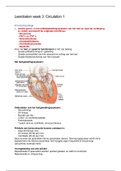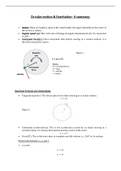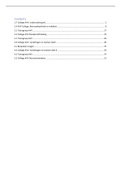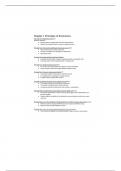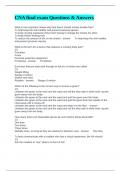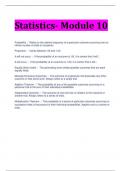ZOL 3702 LEARNING UNIT 2
CONDITIONS
Textbook reference: Page 30-57 chapter one
Learning outcomes:
Describe and interpret graphic models of the influence of conditions on vitality of liveliness and species.
Critically discuss the correlation between temperature and the abundance and distribution of organisms.
Give an overview of the ecophysiological aspects of survival at different temperatures.
Explain the adaptability of ectothermic and endothermic animals at different temperatures.
Explain the adaptability of organisms to pH, salinity, and current flow.
Discuss the possible impact of pollutants.
Evaluate the possible impact on the study of the greenhouse effect and global warming.
An environmental condition is an abiotic environmental factor that varies in space and time, and to which
organisms react in different ways, such as humidity, pH , current flow.
Temperature is the most important environmental condition.
For some conditions we can recognize an optimum concentration or level at which an organism performs
From an evolutionary point of view optimal conditions are those under which the individual leaves the
most descendants.
ECOLOGICAL NICHES (Pg 31)
An ecological niche is the functional place of an organism – not a place but an idea - a summary of the
organism’s tolerances and requirements.
The habitat is the physical place an organism occupies. Each habitat provides many different niches.
It is impossible to visualize a niche of more than 3 dimensions, but the ecological niche can in an abstract
way be regarded as an n-dimensional hypervolume within which a viable population can be maintained –
the Hutchinsonian ecological niche concept)
The modern concept of the niche was proposed by Hutchinson to address ways in which tolerance is a
requirement, interact to define the conditions and resources needed by an individual or species.
All the environmental conditions that can play a restrictive role are included as dimensions in this concept,
as well as the resources that the species requires.
Temperature for example, limits growth and reproduction of all organisms, but different organisms
tolerate different ranges of temperature. This range is one dimension of an organism's ecological niche.
Figure 2.2b shows the way 2 niche dimensions (temperature and salinity) together define a 2D area that is
a part of the niche.
The ability of an organism to remain in this hypervolume is determined by certain factors:
1. The species must be able to colonize (reach the location)
2. The occurrence of the organism can be reduced or totally excluded through competition with other
organisms and predation.
Usually, a species has a larger ecological niche in the absence of competitors and predators.
In other words, there are certain combinations of conditions and resources that can allow a species to
maintain a viable population, but only if it is not being adversely affected by enemies.
This led Hutchinson to distinguish between the fundamental and the realized niche:
- The fundamental niche describes the overall potentials of a species.
- The realized niche describes the more limited spectrum of conditions and resources that allow it to
persist, even in the presence of competitors and predators.
THE REACTIONS OF INDIVIDUALS TO TEMPERATURE (pg 32-41)
Different organisms react differently to temperature.
Words like harsh, hot, and cold should be used by ecologists with care.
METABOLISM , GROWTH , DEVELOPMENT AND SIZE
, Individuals respond to temperature as shown in figure 2.1 A:
impaired function and death at upper and lower extremes , with a
functional range between extremes, in which there is an optimum.
This is accounted for by changes in metabolic effectiveness.
For each 10C rise in temperature, the rate of enzymatic process
often doubles and appears as an exponential curve on a plot of rate
against temperature.
The factor by which a reaction changes over a 10C range is referred
to as Q10; doubling means that Q10 equals roughly 2.
For an ecologist however, effects on individual chemical reactions
are likely to be less important than effects on rates of growth,
development and on final body size since these tend to drive the
core ecological activities of survival, reproduction and movement.
Fig 2.1,2.3 indicate rise in metabolic rate due to rise in temperature.
Within non-lethal temperature extremes, temperature mainly
influences growth and development. This effect is linear because
development is minimal at extreme temperatures.
When the relationship between growth or development is linear, the temperatures experienced by an
organism can be summarized in a single useful value
For instance, Figure 2.4c shows that at 15°C (5.1°C above a development threshold of 9.9°C) the predatory
mite, Amblyseius californicus, took 24.22 days to develop (i.e. the proportion of its total development
achieved each day was 0.041 (= 1/24.22)), but it took only 8.18 days to develop at 25°C (15.1°C above the
same threshold). At both temperatures, therefore, development required 123.5 day-degrees (or, more
properly, ‘day-degrees above threshold’), i.e. 24.22 × 5.1 = 123.5, and 8.18 × 15.1 = 123.5. This is also the
requirement for development in the mite at other temperatures within the nonlethal range. Such
organisms cannot be said to require a certain length of time for development. What they require is a
combination of time and temperature, often referred to as ‘physiological time’.
Day-degrees are determined by no. of days required to develop at a temperature above threshold value
(where no development occurs).
ECTOTHERMS AND ENDOTHERMS
Many organisms have a body temperature that differs little if at all from their environment.
Terrestrial organisms, exposed to the sun and air, are different because they may acquire heat directly by
absorbing solar radiation or be cooled by the latent heat of evaporation of water.
The pathways of heat exchange are shown in figure 2.6.
Various fixed properties may ensure body temperatures are higher or lower than ambient temperatures.
For example, the reflected shiny leaves of desert plants reflect radiation that might heat the leaves.
Endotherms regulate their temperature by the production of heat within their own bodies.
Ectotherms rely on external sources of heat.
CONDITIONS
Textbook reference: Page 30-57 chapter one
Learning outcomes:
Describe and interpret graphic models of the influence of conditions on vitality of liveliness and species.
Critically discuss the correlation between temperature and the abundance and distribution of organisms.
Give an overview of the ecophysiological aspects of survival at different temperatures.
Explain the adaptability of ectothermic and endothermic animals at different temperatures.
Explain the adaptability of organisms to pH, salinity, and current flow.
Discuss the possible impact of pollutants.
Evaluate the possible impact on the study of the greenhouse effect and global warming.
An environmental condition is an abiotic environmental factor that varies in space and time, and to which
organisms react in different ways, such as humidity, pH , current flow.
Temperature is the most important environmental condition.
For some conditions we can recognize an optimum concentration or level at which an organism performs
From an evolutionary point of view optimal conditions are those under which the individual leaves the
most descendants.
ECOLOGICAL NICHES (Pg 31)
An ecological niche is the functional place of an organism – not a place but an idea - a summary of the
organism’s tolerances and requirements.
The habitat is the physical place an organism occupies. Each habitat provides many different niches.
It is impossible to visualize a niche of more than 3 dimensions, but the ecological niche can in an abstract
way be regarded as an n-dimensional hypervolume within which a viable population can be maintained –
the Hutchinsonian ecological niche concept)
The modern concept of the niche was proposed by Hutchinson to address ways in which tolerance is a
requirement, interact to define the conditions and resources needed by an individual or species.
All the environmental conditions that can play a restrictive role are included as dimensions in this concept,
as well as the resources that the species requires.
Temperature for example, limits growth and reproduction of all organisms, but different organisms
tolerate different ranges of temperature. This range is one dimension of an organism's ecological niche.
Figure 2.2b shows the way 2 niche dimensions (temperature and salinity) together define a 2D area that is
a part of the niche.
The ability of an organism to remain in this hypervolume is determined by certain factors:
1. The species must be able to colonize (reach the location)
2. The occurrence of the organism can be reduced or totally excluded through competition with other
organisms and predation.
Usually, a species has a larger ecological niche in the absence of competitors and predators.
In other words, there are certain combinations of conditions and resources that can allow a species to
maintain a viable population, but only if it is not being adversely affected by enemies.
This led Hutchinson to distinguish between the fundamental and the realized niche:
- The fundamental niche describes the overall potentials of a species.
- The realized niche describes the more limited spectrum of conditions and resources that allow it to
persist, even in the presence of competitors and predators.
THE REACTIONS OF INDIVIDUALS TO TEMPERATURE (pg 32-41)
Different organisms react differently to temperature.
Words like harsh, hot, and cold should be used by ecologists with care.
METABOLISM , GROWTH , DEVELOPMENT AND SIZE
, Individuals respond to temperature as shown in figure 2.1 A:
impaired function and death at upper and lower extremes , with a
functional range between extremes, in which there is an optimum.
This is accounted for by changes in metabolic effectiveness.
For each 10C rise in temperature, the rate of enzymatic process
often doubles and appears as an exponential curve on a plot of rate
against temperature.
The factor by which a reaction changes over a 10C range is referred
to as Q10; doubling means that Q10 equals roughly 2.
For an ecologist however, effects on individual chemical reactions
are likely to be less important than effects on rates of growth,
development and on final body size since these tend to drive the
core ecological activities of survival, reproduction and movement.
Fig 2.1,2.3 indicate rise in metabolic rate due to rise in temperature.
Within non-lethal temperature extremes, temperature mainly
influences growth and development. This effect is linear because
development is minimal at extreme temperatures.
When the relationship between growth or development is linear, the temperatures experienced by an
organism can be summarized in a single useful value
For instance, Figure 2.4c shows that at 15°C (5.1°C above a development threshold of 9.9°C) the predatory
mite, Amblyseius californicus, took 24.22 days to develop (i.e. the proportion of its total development
achieved each day was 0.041 (= 1/24.22)), but it took only 8.18 days to develop at 25°C (15.1°C above the
same threshold). At both temperatures, therefore, development required 123.5 day-degrees (or, more
properly, ‘day-degrees above threshold’), i.e. 24.22 × 5.1 = 123.5, and 8.18 × 15.1 = 123.5. This is also the
requirement for development in the mite at other temperatures within the nonlethal range. Such
organisms cannot be said to require a certain length of time for development. What they require is a
combination of time and temperature, often referred to as ‘physiological time’.
Day-degrees are determined by no. of days required to develop at a temperature above threshold value
(where no development occurs).
ECTOTHERMS AND ENDOTHERMS
Many organisms have a body temperature that differs little if at all from their environment.
Terrestrial organisms, exposed to the sun and air, are different because they may acquire heat directly by
absorbing solar radiation or be cooled by the latent heat of evaporation of water.
The pathways of heat exchange are shown in figure 2.6.
Various fixed properties may ensure body temperatures are higher or lower than ambient temperatures.
For example, the reflected shiny leaves of desert plants reflect radiation that might heat the leaves.
Endotherms regulate their temperature by the production of heat within their own bodies.
Ectotherms rely on external sources of heat.


